43 7.3 cell transport worksheet answers
PDF 7.3: CELL TRANSPORT - West Linn-Wilsonville School District 7.3: CELL TRANSPORT (across the cell membrane!) Vocabulary • Osmosis • Diffusion • Facilitated Diffusion • Active Transport • Endocytosis • Exocytosis • Protein Pumps • Osmotic Pressure • Isotonic • Hypertonic • Hypotonic Background Info… • Every living cell contains a liquid interior (cytoplasm) and is surrounded by a liquid. Biology: A View of the Cell - Science Classroom Teacher Resources Chapter 7: A View of the Cell. Chapter 7 Outline . Section 7.1 Resources: " The Discovery of Cells " self-check quiz. Section 7.3 Resources: Play the online "Cell Organelles" game. Chapter Resources: "A View of the Cell" chapter review. "Cells" crossword puzzle. "Cells" word search puzzle.
PDF 7.3 Cell Transport Active transport takes place when the cell uses energy to carry a substance across the cell membrane against a concentration difference. Follow the directions. 1. Label each diagram as either facilitated diffusion or active transport. Answer the questions. Circle the correct answer. 2. Which process can move molecules from a lower concentration ...

7.3 cell transport worksheet answers
Lesson 7.4 Homeostasis and Cells Flashcards | Quizlet the cells of multicellular organisms become specialized for particular tasks and communicate with one another to main rain homeostasis. Cell specialization. types of cells playing different roles. Tissue. a group of similar cells that preforms a particular function. Organ. group of tissue that work together to preform closely related functions. Chapter 7.3 and 7.4 | Biology Quiz - Quizizz answer choices communicate with other cells reproduce grow respond to the environment Question 8 900 seconds Q. Molecules which cross a plasma membrane by active transport: answer choices require the use of energy (ATP). require the aid of carrier proteins move from an area of high concentration to an area of low concentration. PDF 7.3 Cell Transport Cells are in an isotonic solution. 6. Cells are in a hypertonic solution. 7. Cells are in a hypotonic solution. Result A. The cells lose water. B. The cells gain water. C. The cells stay the same. 8. In the table below, draw how each type of cell will look after being placed in a hypertonic solution.
7.3 cell transport worksheet answers. Cell Structure and Function that help the cell stay alive. SAMPLE ANSWER: Materials must cross the cell membrane to enter or leave a cell. SAMPLE ANSWER: A cell can transport materials across the membrane through passive transport, which does not require energy. A cell can move materials by active transport, which needs energy. SAMPLE ANSWER: Cells are able to maintain ... Solved Worksheet for Chapter 7 1. List all the components of | Chegg.com Transcribed image text: Worksheet for Chapter 7 1. List all the components of the Fluid Mosaic Model of the membrane (fig. 7.3). Do not draw it. Just make a list 2. List some of the functions of the membrane proteins (fig.7.7) 3. In your own words describe how the plasma membrane works 4. List the Passive and active mechanisms of transport 5. PDF Biology Core - PC\|MAC 3.2.1: Study - Cell Membrane Structure Duration: 40 min 3.2.2: Quiz - Cell Membrane Structure Duration: 20 min _____ / 20 3.2.3: Study - Cellular Transport Duration: 40 min 3.2.4: Quiz - Cellular Transport Duration: 20 min _____ / 20 Lesson 3.3: Cell Differentiation 3.3.1: Study - Specialized Cells and Tissues Duration: 40 min Chapter 7, Cell Structure and Function - 7.3 - Cell Transport - GradeSaver Chapter 7, Cell Structure and Function - 7.3 - Cell Transport - 7.3 Assessment - Page 213: 4 Answer -cytosis means a process of a cell Work Step by Step Pinocytosis would mean the process of a cell drinking. Phagocytosis would mean the process of a cell eating. Update this answer! You can help us out by revising, improving and updating this answer.
Chapter 7, Cell Structure and Function - GradeSaver Chapter 7, Cell Structure and Function - Assessment - 7.3 Cell Transport - Understand Key Concepts - Page 220: 19 Answer The difference between active and passive transport is that active transport requires energy and passive transport does not. Work Step by Step 7.3 wb transport ANSWERS.doc - Name Class Date 7.3 Cell... Name Class Date 7.3 Cell Transport Lesson Objectives Describe passive transport. Describe active transport. Lesson Summary Passive Transport The movement of materials across the cell membrane without using cellular energy is called passive transport. Diffusion is the process by which particles move from an area of high concentration to an area of lower concentration. Download Free Chapter 7 Cell Structure And Function Section Boundaries ... Chapter 7 Cell Structure and Function Worksheet Answer Key Chapter 7: Cell Structure and Function. Terms in this set (40) cell. collection of living matter enclosed by a barrier that separates the cell from its surroundings; basic unit of all forms of life. cell theo- ry. Chapter 7- Cell structure and Function I. Cellular Life A. Life is cel- Unit 3 Cell Transport Summative Assessment on the Cell Membrane and Transport HW: Rad 2.4 More + Friday 10/31 QOD: Describe passive transport and give 3 examples. HW: Ch. 7.3 worksheet; check answers with answer key posted on the right; STUDY for Quest on Monday. Thursday, 10/30. A cell has a 20% solute concentration in an environment of 80% water concentration.
1.4 Membrane Transport - IB Biology Resources 1.4.U1 Particles move across membranes by simple diffusion, facilitated diffusion, osmosis and active transport. 1.4.U2 The fluidity of membranes allows materials to be taken into cells by endocytosis or released by exocytosis. 1.4.U3 Vesicles move materials within cells. Cells and Transport (Ch 7 and 8.1) - 332_janecruce - Google Current Event Responses are due Cell Vocabulary Quiz #1 - This quiz will cover the vocabulary from sections 7.1, 7.2, and 8 words from 7.3 (cell wall through cytoskeleton...please see p.191 in your... Download File PDF Chapter 7 Cell Structure And Function Section ... Chapter 7 Cell Structure and Function Worksheet Answer Key. Worksheet Novem-ber 11, 2017 03:33. Pick the worksheets you plan to relocate or copy. The work-sheet ought to be short, crisp, easy and easy and child-friendly. Functions Work-sheet Pdf The response worksheet will surely demonstrate the progression of just how ideal to care for the ... 1.3.6 Active transport - Save My Exams The energy from respiration is used by protein transport molecules embedded in the cell membrane to move substances into or out of the cell Active transport moves substances from a more dilute solution to a more concentrated solution Active transport across the cell membrane involves protein carrier molecules embedded in the cell membrane
Ch. 7 Chapter Summary - Biology 2e | OpenStax 7.1 Energy in Living Systems. ATP functions as the energy currency for cells. It allows the cell to store energy briefly and transport it within the cell to support endergonic chemical reactions. The structure of ATP is that of an RNA nucleotide with three phosphates attached. As ATP is used for energy, a phosphate group or two are detached ...
Membrane Transport - BIOLOGY FOR LIFE Essential Idea: Membranes control the composition of cells by active and passive transport. 1.4.U1 Particles move across membranes by simple diffusion, facilitated diffusion, osmosis and active transport. Describe simple diffusion. Explain two examples of simple diffusion of molecules into and out of cells.
cellular transport worksheet Cellular Transport Worksheet Answer Key - Worksheet List. 16 Images about Cellular Transport Worksheet Answer Key - Worksheet List : Cellular Transport Worksheet Name, Section 7.3 Cell Transport Answers | PSLK Best Answer Key Guide Storage and also Cell membrane. Cellular Transport Worksheet Answer Key - Worksheet List nofisunthi.blogspot.com
Chapter 10 Energy In A Cell Worksheet Answers cellular energy is called passive transport. (Diffusion is the process by which panicles move from an area of high concentration to anPrint Energy and Life: The Transformation of Energy in Living...
PDF Chapter 7: How Cells Harvest Energy AP - McGraw Hill Education The electron transport chain in the mitochondria of eukaryotic cells is used to move electrons in order to capture energy efficiently. The ultimate goal of cellular respiration is synthesis of ATP. ATP is then used to power most of the cell's activities. Cells can make ATP through two different mechanisms: (1) Substrate-level phosphorylation, in
Cell Transport 7.3 Pearson - Answers (Passive Transport) View Notes - Cell Transport 7.3 Pearson - Answers (Passive Transport) from SCIENCE Biology at Manalapan High. Passive Transport For Questions 14, write the letter of the correct answer on the line at ... 7_3_worksheet Biology.docx. homework. 3. D0794803_C07_L03_Lesson_Review_Workbook_A.doc. University of Maine. BIO MISC. Active Transport;
PDF AP Biology Cellular Respiration Chapter 7 Reading Guide ANSWER KEY with ... The resulting H+ gradient stores potential energy available to do cellular work. 18. Summarize the net ATP yield from the oxidation of a glucose molecule by constructing an ATP ledger. Glycolysis: 4-2 = 2 ATPs, Krebs Cycle = 2 ATPs, Electron Transport Chain = 26 to 28 ATPs. Total of 30 to 32 ATP molecules from the complete oxidation of glucose. 19.
PDF Cell Transport Practice Test - St. Johns County School District c. cellular energy forces molecules to collide with each other. d. cellular energy pumps molecules across the cell membrane. ____ 5. During diffusion, when the concentration of molecules on both sides of a membrane is the same, the molecules will a. move across the membrane to the outside of the cell. b. stop moving across the membrane.
PPTX Cell Transport Powerpoint - Lake Station Community Schools 7.3 Cell Transport 2006-2007 Function of the Cell Membrane: Cell membrane separates the components of a cell from its environment—surrounds the cell Regulates the flow of materials into and out of cell— selectively permeable Cell membrane helps cells maintain homeostasis —stable internal balance Passive Transport
Unit 3: Cell Transport - Mrs. Benart's Biology - Google Passive Transport worksheet 3.6 Cell membrane and transport video notes 3.7 Cell transport webquest 3.8 Eggsperiment! 3.9 ...
7.4 Homeostasis and Cells Flashcards | Quizlet 15 answers. QUESTION. According to the government budget constraint, any excess of public expenditures and transfers over taxes and user fees must be funded by ... kgraceh113. 7.3 Cell Transport. 24 terms. kgraceh113. 7.1 Life is Cellular. 27 terms. kgraceh113. 7.4 Homeostasis and Cells. 7 terms. ashley_aldeza. Sets with similar terms. Biology ...
PDF 7.3 Cell Transport Cells are in an isotonic solution. 6. Cells are in a hypertonic solution. 7. Cells are in a hypotonic solution. Result A. The cells lose water. B. The cells gain water. C. The cells stay the same. 8. In the table below, draw how each type of cell will look after being placed in a hypertonic solution.
Chapter 7.3 and 7.4 | Biology Quiz - Quizizz answer choices communicate with other cells reproduce grow respond to the environment Question 8 900 seconds Q. Molecules which cross a plasma membrane by active transport: answer choices require the use of energy (ATP). require the aid of carrier proteins move from an area of high concentration to an area of low concentration.
Lesson 7.4 Homeostasis and Cells Flashcards | Quizlet the cells of multicellular organisms become specialized for particular tasks and communicate with one another to main rain homeostasis. Cell specialization. types of cells playing different roles. Tissue. a group of similar cells that preforms a particular function. Organ. group of tissue that work together to preform closely related functions.

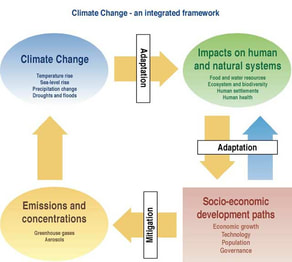
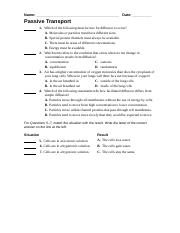



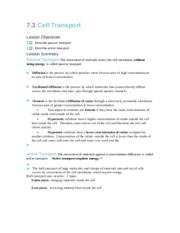









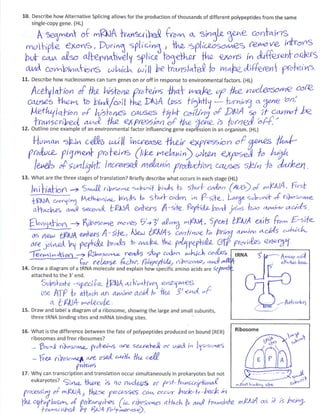

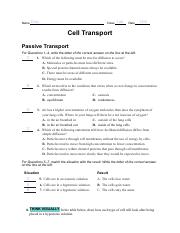




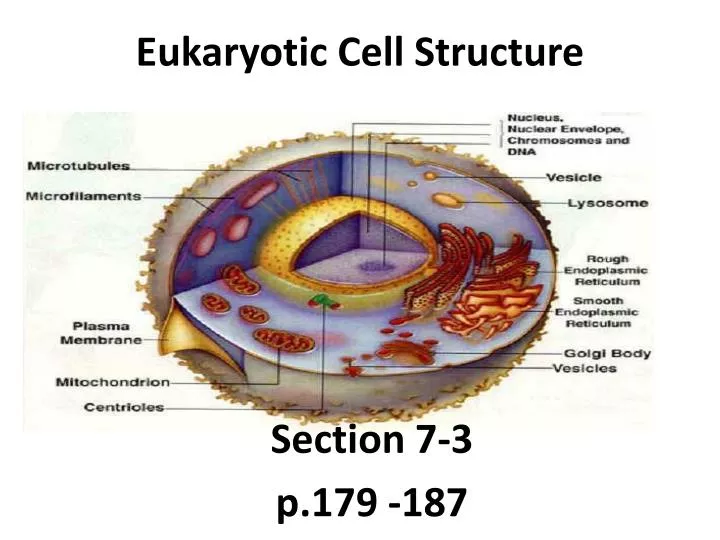
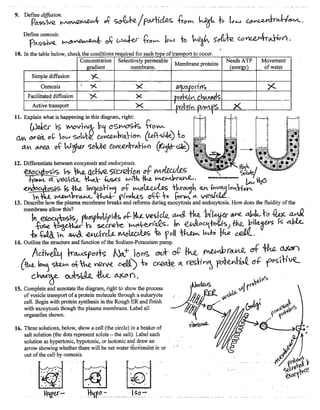

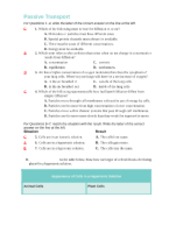
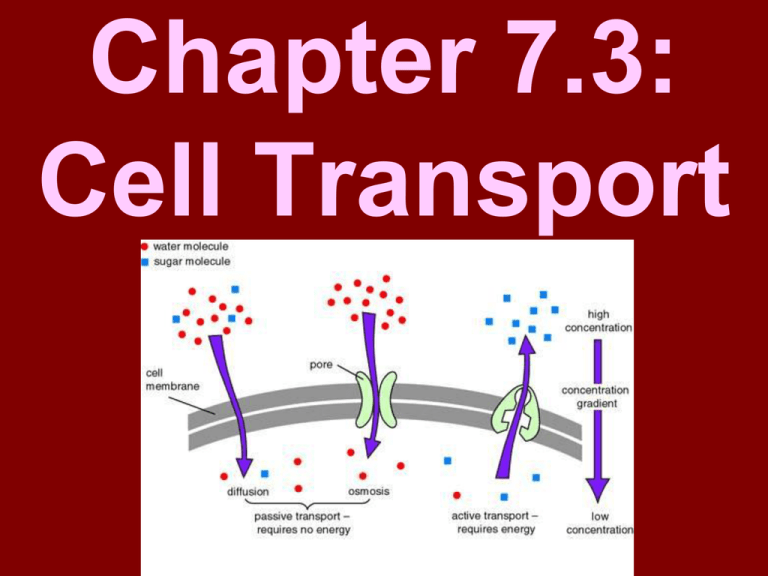

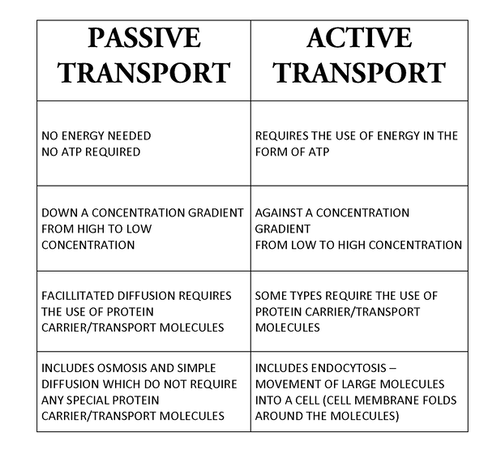


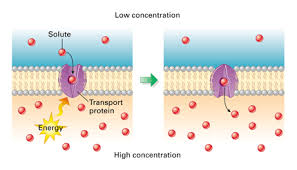



0 Response to "43 7.3 cell transport worksheet answers"
Post a Comment